This fact sheet presents highlights from the Food Action Planning Committee Meeting and the subsequent Urban Agriculture and Food Sustainability Forum held at University of Nevada Cooperative Extension in partnership with the Southern Nevada Strong (SNS) initiative and the Southern Nevada Regional Planning Coalition. A short history of the Southern Nevada Food Council is included for reference. Additionally, a summary of participant feedback and evaluation results are included.
Introduction
The Coalition received a presentation from a local team of urban agriculture proponents (Rick Van Diepen, Rick Passo and Ric Jimenez) about vertical farming and urban agriculture planning and possibilities on Sept. 27, 2016 (Southern Nevada Regional Planning Coalition, 2016). Out of this presentation, a motion to hold a summit focused on urban agriculture and economic diversification was introduced and passed by members of the Coalition. Months later, Extension offered to organize the event in collaboration with the urban agriculture proponents and staff from the Coalition and SNS.
The partnership between Extension and SNS facilitated the organization of the forum for the Coalition. Extension’s mission “…to discover, develop, disseminate, preserve and use knowledge to strengthen the social, economic and environmental well-being of people,” and its Extension functions revolving around food, agriculture, health and nutrition, among others, placed it as an ideal venue with excellent resources to facilitate the forum. The SNS staff saw this forum as an opportunity to complement their efforts to implement the SNS Regional Comprehensive Plan, especially with regard to food-related strategies, and thus acted to support the event and become a forum partner.
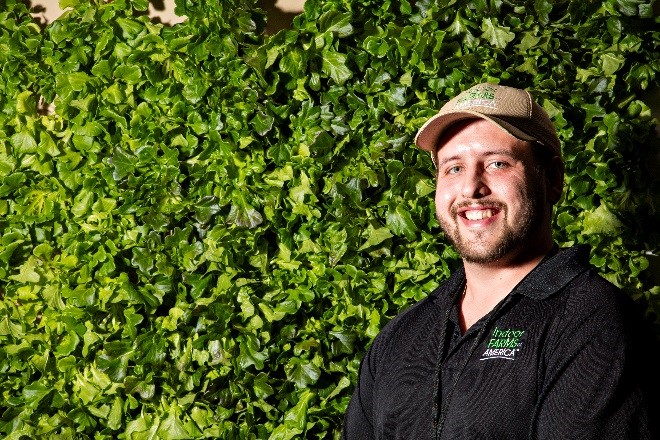 Leafy greens grow on a vertical aeroponic panel by Indoor Farms of America.
Leafy greens grow on a vertical aeroponic panel by Indoor Farms of America.
Food Action Planning Committee Meeting, Aug. 23, 2017
The purpose of this meeting was to identify food policy goals and objectives as outlined in the Southern Nevada Strong plan for the purpose of examining strategies to implement a food action plan for Southern Nevada. Members and supporters that were on the Southern Nevada Food Council update distribution list were invited to ensure they were included in the discussion as it pertained to the future direction of the Council.
A Short History of the Southern Nevada Food Council
The food system can be complex and consist of many elements including the activities, the people and the resources that take food from the field to the plate. Consequently, all of these elements are intertwined with public health, equity issues, and the environment and can influence each other (Johns Hopkins Center for a Livable Future, 2017). Thus, a group of stakeholders representing various elements of the food system that come together with the goal of improving the food system through collaboration, systems and policy change is often referred to as a food policy council (Burgan & Winne, 2012).
The Vegas Valley Community Food Council was created by Three Square Food Bank after it held a public brainstorming meeting in August 2011 to determine the community’s interest in food policy issues and to lay the groundwork for a potential food policy council in southern Nevada. Issues that had emerged from that meeting were as follows:
- Mobile markets
- Community gardens
- Nutrition education
- SNAP at farmers markets
- Farm to School / School Garden programs
- Fundraising and grant writing collaboration
- Online community food security site
- Marketing of fruit tree gleaning programs through Homeowners’ Associations (HOAs)
Much progress has been made on these issues since the initial meeting in 2011, some attributable to the collaboration and efforts made by several organizations initially invested in the Council. These organizations included Three Square Food Bank, Southern Nevada Health District, University of Nevada Cooperative Extension, Project Angel Faces, City of Las Vegas, Culinary Academy of Las Vegas, Las Vegas Farmers Market, and a handful of passionate individuals, all of whom participated and supported Council meetings and early collaborations.
Staff from Three Square Food Bank facilitated the meetings which initially were held on their premises and later were moved to different locations in the spirit of collaboration. A Farms and Family Festival was held by Council members in May 2012 at the Springs Preserve to help educate the community about local food production. Membership was voluntary, and people or organizations who regularly contributed or attended meetings were considered members.
The Southern Nevada Health District secured technical assistance from a food policy council expert, Mark Winne, to help with strategic planning. A white paper (Vegas Valley Community Food Council, 2012) was developed in anticipation of the strategic planning session, which was conducted at the Springs Preserve on Nov. 16, 2012, with Council members and others interested in supporting a local food policy council. Structure of the early Council following the planning session was kept informal, since members wanted to maintain it as a grassroots organization that would not be subject to external rules or regulations. In May 2013, the name of the Council was changed to the Southern Nevada Food Council to better represent the region and be more inclusive of the rural areas that contribute to the local food system and surround the Las Vegas Metropolitan Area.
Facilitation of Council meetings was handed over to the staff at the Health Department Office of Chronic Disease Prevention and Health Promotion in late 2013. Meetings provided an opportunity for people to network and learn about each other’s work in the food system. Health Department staff sent out monthly updates to keep members apprised of grant or collaboration opportunities, news, member or other food-related events, and updates on policy, especially when the Nevada Legislature was in session.
In April 2016, facilitation of the Council moved to University of Nevada Cooperative Extension in Clark County. With the increasing interest and push for local food production, it became evident that a more formal council structure would be needed to move from simply networking and exchanging information to effecting systems and policy change with the purpose of improving the local food system. Thus the Food Action Planning Committee Meeting was held to engage members and receive guidance from a recognized food-system and food-policy expert.
Food Action Planning Committee Meeting, Aug. 23, 2017
The meeting began with a welcome announcement from Extension Southern Area Director, Eric Killian, and was followed by an overview and update from the Council by Extension Public Health Nutrition Specialist, Aurora Buffington. The meeting also featured a presentation about SNS goals and objectives relating to urban agriculture and healthy food systems by Regional Transportation Commission of Southern Nevada Regional Planning Manager, Rae Lathrop, and breakout planning sessions to brainstorm solutions for food-related SNS strategies.
Southern Nevada Strong
The Southern Nevada Strong (SNS) Regional Plan is a comprehensive plan for growth and development which addresses transportation, housing, education and healthcare (Southern Nevada Strong, 2015). Recognizing that the SNS Regional Plan contained many food-related strategies, SNS staff shared some of those strategies (Table 1) with meeting participants to stimulate thought on implementation and who should be or already was involved. This presentation was followed by planning sessions.
Planning Session Findings
Participants were split into three groups that examined one or two SNS strategies at a time, then they were asked to brainstorm and list key stakeholders, activities or programs, and opportunities or challenges that would fall under the strategies. In some cases stakeholders were already doing the work, in others, they were presented as good candidates. Some activities on the lists were ideas or best practices happening outside of southern Nevada, while others were already being implemented. The goal of the session was to generate a list for each food, or agriculture-related SNS strategy (Table 1).
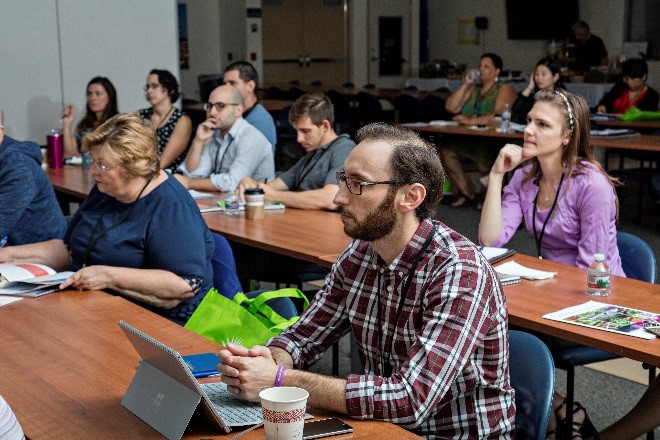 Council members listen to presentation about food-related SNS goals.
Council members listen to presentation about food-related SNS goals.
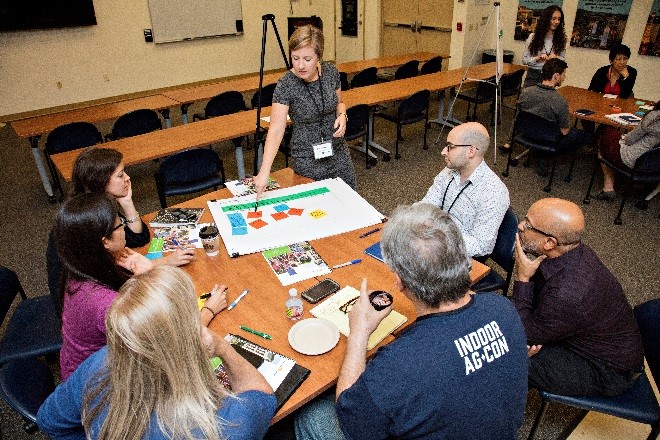 Rae Lathrop leads a brainstorming activity.
Rae Lathrop leads a brainstorming activity.
Table 1 – Planning Session Group Activity Food Action Planning Committee Meeting, Aug. 23, 2017
SNS Strategy 3.2.1: To advance the priorities of Food Security in Nevada, Nevada’s Plan for Action, support in-depth research on existing or emerging geographic concentrations of food-insecure populations within Clark County.
| Programs and Activities |
Key Stakeholders |
Opportunities and Challenges |
- Indoor ag
- Fresh food year-round
- Home Garden Kits: tree seeds, free transplants, education and tools, free containers
- Prenatal Education
- Big box to indoor ag (jobs program, food availability)
- Expand program to provide free bus passes to transport people in food-insecure areas to nearest grocery store
- Food hubs: markets, community gardens, education spaces, food distribution
- Create funding opportunities
- Jobs for low-income people and transportation for them
- City position to fast-track projects in sustainability through government communication and cooperation
- Food access points: libraries, schools
|
- Three Square Food Bank
- Indoor Farms of America (aeroponics)
- Urban Seed Inc. and its Foundation
- Food pantries
- Urban Ag School at UCLA
- Transportation
|
- High demand of local food overall
- Great market opportunities with high-end restaurants with indoor ag
- Funding
- Zoning and development code regulation for indoor ag
- Funding to support complete food communities; mega-industries must have budget, including marijuana business
|
SNS Strategy 3.2.2: Support and coordinate with organizations working to increase access to healthy food options, including Southern Nevada Health District, Southern Nevada Food Council and the School of Community Health Sciences at University of Nevada Las Vegas, to identify underserved areas that could support healthy food outlets, urban agriculture, community gardens and farmers markets.
| Programs and Activities |
Key Stakeholders |
Opportunities and Challenges |
- Mobile farmers market*
- Healthy food trucks
- Healthy corner stores in food deserts
- Not enough farmers markets
- Produce market
- Farmers market accessibility
- Online grocery shopping (accept SNAP/EBT)*
- Modify health (department) regulations on dairy and beef
- Variety from food banks / choice
- Raiders Garden Group
- Food access points: libraries, schools
- Food policy and practice research repository
- Veggie RX*
|
- Indoor Ag
- Community gardens
- Three Square Food Bank
- Zoning/Planning departments
- Pharmacies
- Raiders
- WIC
|
- SNAP retailers
- Incorporating local produce
- Community building: transport, supply, food safety, spoilage
- Learning to eat seasonally
- Zoning regulations
- Political terminology
- Accreditation program similar to slow food / local branding
- Mobility, funding, scheduling
- Source of refrigeration distribution points
- Loading and distribution points
- Integration of: horticulture therapy, art-making therapy with community place-making for a more healthy vibe
- Define urban ag terms
|
SNS Strategy 3.2.3: Promote healthy food options and ensure Supplemental Nutritional Program (SNAP) benefits are available in areas with concentrations of fast food outlets that also have high food insecurity rates.
| Programs and Activities |
Key Stakeholders |
Opportunities and Challenges |
- Increase capacity of corner stores to provide fresh products
- Tax incentives for retailers in food deserts
- Bus wrap messages about healthy food options
- Support the City of Henderson to get their farmers market SNAP authorized
- Support community and school gardens with maintenance*
- SNAP outreach (Three Square)*
- SNAP-Ed*
- Nutrition education such as Cooking Matters, for low-resource families*
- Provide local SNAP education*
- Extension cooking and nutrition classes providing SNAP-Education*
- Survey of corner stores that carry fresh produce
- Innovative farming (indoor grow walls, aquaponics, hydroponics, etc.)
- Multigenerational garden projects
- FINI grant*
- Farmers markets*
- Mobile food pantry*
- Food preservation classes (Extension)*
|
- Three Square Food Bank
- Clark County School District Schools
- Division of Welfare and Supportive Services
- Market managers and (food) retailers
- Churches or faith-based involvement
- Casinos
- Producers
- Head Start
- State SNAP Outreach Partners
- Mobile food markets: Whole Foods, Sprouts, donations
- Uber trucking for produce
- Community, senior and recreation centers (Parks and Rec)
- Boys & Girls Clubs
- Winchester Cultural Center
- Great Farm Irvine, CA
- University of District Columbia
- Green Bronx Machine
|
- Clark County School District
- Food desert access
- Education SNAP/EBT
- Stigma of needing help
- Southern Nevada Health District cooperation; rules and regulations, updates
- Cultural diversity “food choices”, how to get these into farmers market
- Data showing fast-food density
- Feat of reprisal at the family level
- Increased SNAP enrollment among seniors and immigrants
- Refrigeration, food prep and canning, drying options to preserve food
- Local government involvement
- Mobile market, sustainability of same, permits, etc.
- Multigenerational collaboration lacking
|
SNS Strategy 3.1.1: Work with the healthcare industry to promote community wellness, and become partners with municipalities to build “healthy communities,” like those championed by the Centers for Disease Control.
| Programs and Activities |
Key Stakeholders |
Opportunities and Challenges |
- Community pools and swimming programs
- Case study research, Hillview Urban Ag Center, Baltimore, Philadelphia
- Integrate public policy medical district, combine policy areas for mutual benefits
- Use beneficial grants for interim use – gardening/soil to get ready for next use
- Food hackathon pop-up events
- Long-term care and transportation for better / healthy living
- Focus healthy, active living techniques with psychiatric health professionals
- Edible landscaping in public spaces
- More dedicated bike lanes, greenways*
- Partnership to expand bike share
- Prescription for outdoor activity
- Exercise as medicine
- Mobile farmers markets
- Mobile health clinic*
- Engage a variety of professionals: public health, nutrition, fitness and exercise, planners, etc.
- Expand medical services, gym
|
- Touro University
- Cleveland Clinic
- Roseman University
- University of Nevada, Las Vegas School of Medicine
- College of Southern Nevada and Clark County School District
- Pharmacies and wellness clinics
- Southern Nevada Health District
- Gyms, yoga studios, spas, nontraditional medical care
- Farmers
- Rec centers
- Libraries
- Pittman neighborhood revitalization plan – Invest Health project
|
- Homebuilders
- Gated communities
- Our existing city’s layout not walkable
- Environment safety of neighborhoods, parks, bike paths, etc.
- Define healthy communities
- Builders control development pattern
- Integration of public health, medical schools, research, economic diversification
- Remediation of brownfields – opportunities for community gardens, green spaces, exercise facilities
- Foodies trend; education around cooking with fresh, healthy foods
- Lack of access to fresh food
- Heat during the summer
|
SNS Strategy 3.1.4: Partner with organizations that are promoting wellness programs and working to reduce obesity and childhood obesity.
| Programs and Activities |
Key Stakeholders |
Opportunities and Challenges |
- SNAP-Ed: All 4 Kids, Chefs for Kids/Pick A Better Snack, Little Books & Little Cooks (cooking class for parents and young children), etc. (several implementing agencies)*
- UNCE Seniors Eating Well, Healthy Kids Festival, Healthy Steps to Freedom*
- Veggie Buck Truck*
- EFNEP (Expanded Food & Nutrition Education Program) through Extension*
- Grocery store tours w/$10 credit
- Food rescue
- Garden Clubs in Schools*
- Foodbank purchase of excess farmers market products
- Healthy recipe preparations*
|
- SNAP-Ed implementing agencies such as Extension
- Three Square Food Bank
- Southern Nevada Health District
- Green Our Planet
- Vegas Roots Garden
- Regional Transportation Commission
- Employee Wellness Union
- Clark County School District and Head Start Program
- Children’s Heart Center
- Osher Lifelong Learning Institute
- American Heart Association
- Parks and Rec, Boys & Girls Club, YMCA, Safekey, etc.
- Urban Seed Foundation
- Libraries
- Create A Change Now
- Farmers Markets
- Hotels to get unused food
- Local pro sports teams
- Partners for a Healthy Nevada
|
- Educating parents
- Food deserts
- Food rescue, food markets
- Create micro grocery stores with fresh food and education using “WIC only” stores in California as model
- Central loading dock, freight, refrigeration process
- Model Green Bronx Machine program paying low-income students to build and operate indoor ag
- Nuts – proteins, roasting, preparation
- Accessible healthy food choices in schools – making healthy food choices the easier choice
|
SNS Strategy 5.8.3: Introduce regional composting pilot program utilizing the Environmental Protection Agency (EPA)-supported best practices for establishing a composting program.
| Programs and Activities |
Key Stakeholders |
Opportunities and Challenges |
- Las Vegas Springs Preserve, Extension (Education)
- Restaurants, restaurant association, University of Nevada, Las Vegas, College of Southern Nevada
- Bay area residential composting program (also in schools)
- Pig farm, food waste reduction/reuse, recover hotels*
- Flyer on trash cans (about educating)
- Community composting collection and drop off
- Vermicomposting for kitchens
- Composting bins that are serviced by company
- Christmas tree composting, etc.
- Composting education
- Incentives for community nurseries
- Composting systems set up in schools - Promote composting education and environmental education* (Green Our Planet)
- Anaerobic digester / aerobic composting (energy source)
- Clark County School District school buses run on used cooking oil*
- Composting education
|
- Clark County School District
- Strip hotels
- Grocery stores
- Homeowners’ associations
- Review-Journal
- Trash and recycling companies
- Clark County School District cafeterias
- Gas company – Call before you dig (bill insert/handout)
- Existing community composting companies
- Republic Services
- Recycling Coordinator, Nevada Division of Environmental Protection
- Resorts and pig farms
- Terra Firma Composting
- Green Our Planet
- Restaurants and casinos / hotels
- Child care centers
- Landscape companies
|
- Food waste to energy – CO2 (and drying technology)
- Organic versus inorganic compost
- Cost-benefit may take decades to see
- Asking Republic Services to support community composting program
- Individual versus community composting
- Outdoor composting – attracts birds – hazard to airplanes
- Kitchen composting attracts bugs
- What can we grow here?
- Composting education
|
*Indicates an activity that is currently underway in the Las Vegas Metropolitan Area. +Name of individual excluded. Words and phrases are listed as participants gave them during the planning session.
Food Action Recommendations
The meeting concluded with a message from an international speaker, Wayne Roberts, a Canadian food-policy analyst and writer leading in the field of innovative local and urban food systems. Roberts said he was impressed by the participants’ skills, SNS plans and the positive energy. He proceeded to provide his observations highlighting three areas: strengths, food as a tool and quick starts.
Strengths in the Las Vegas Metropolitan Area
- The SNS Regional Plan is a strength because it lays the framework for a complete community.
- A land-grant university presence brings resources that are useful to move food forward in the Las Vegas Metropolitan Area.
- With over 40 million annual visitors, the potential to influence a change in norms exists through messaging in public spaces that experience vast amounts of foot traffic, such as the airport.
- Las Vegas is positioned to be on the cutting edge of indoor agriculture due to its desert climate, need to conserve water, and great potential to use solar energy for food production.
- The Clark County School District has a robust school garden program.
Food as a Tool
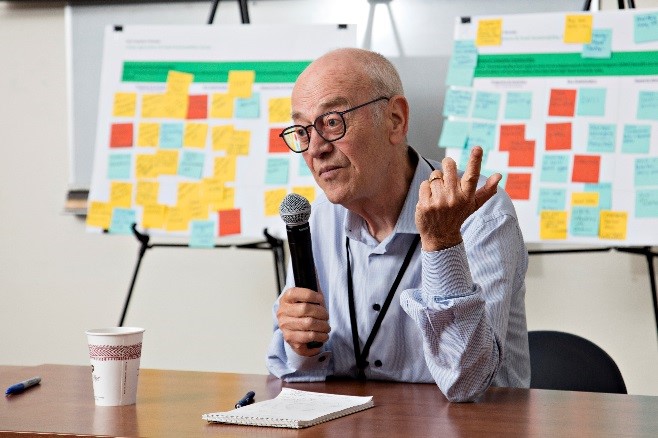 Wayne Roberts provides feedback based on participant input and SNS goals.
Wayne Roberts provides feedback based on participant input and SNS goals.
- Food may be used to provide leverage with other initiatives.
- Example 1: 88 percent of households use a car to buy groceries at least once per week, totaling 42 billion miles in the United States (Environmental Protection Agency, 2017). Imagine the difference that could be made if one out of five people stopped driving for groceries.
- Example 2: Research shows that washing hands with soap and water is as effective as using hot water (Jensen et al., 2017). Imagine the savings in water that could be made if people didn't run water to get it hot before washing their hands.
Quick Starts
- It will be advantageous to focus on solutions to problems that can be accomplished quickly, with minimal investment that will produce a great return.
- A champion with a team of people around him/her is usually needed to resolve an issue, so leadership will be essential.
- A food-policy council is a type of issue management organization that can use a “quick-start” filter to prioritize issues.
Urban Agriculture and Food Sustainability Forum, Aug. 24, 2017
The following day consisted of the 2017 Southern Nevada Urban Agriculture and Food Sustainability Forum featuring Roberts as the keynote speaker. The forum’s purpose was to create a blueprint for urban agriculture policy and economic diversification to support an equitable and sustainable food system for southern Nevada. The forum consisted of panels and presentations, as well as extracurricular activities that showcased urban agriculture.
Extension Garden Tours
The forum started with a tour of Extension’s Botanical Gardens provided by Master Gardener volunteers. The Gardens showcase over 1,300 species of plants, including trees, shrubs, perennials, cacti and agaves that grow in the desert. Some favorites include the herb garden, palm tree demonstrations, small fruit orchard, composting section, vegetable garden and a rose garden among others. The gardens are maintained by UNCE Master Gardeners who possess advanced plant-science skills and have earned their certification by attending 50+ hours of classroom instruction. In order to maintain their certification, Master Gardeners commit to serving a minimum of 50 volunteer hours in the community annually.
Opening Presentations
Opening presentations were designed to provide a foundation for concepts related to urban and indoor agriculture. SNS staff provided a review of the SNS Regional Plan, highlighting its food related strategies. Corrie Bosket, Extension coordinator of conservation issues, provided an overview of other food-related plans, policies, documents and related research including:
- The Governor’s Office of Economic Development brochure on Commercial Indoor Agriculture
- The Governor's Proclamations regarding STEM education and Food Day from Oct. 24, 2016
- The USDA Natural Resources Conservation Service’s resources on Urban Agriculture
- Southern Nevada Food Council White Paper
- City of Las Vegas Food Access Policy & Planning Guide
- City of Las Vegas R-44-2013 Resolution committing the city to increasing access to healthy foods and adopting a food access policy and planning guide
- Hydroponics and high tunnels research from the College of Agriculture, Business and Natural Resources at University of Nevada, Reno
- Public Law 114-59, STEM Education Act of 2015
- SB 429, Urban Ag bill
- SB 167, School Garden bill
- Nevada's Strategic Planning Framework, 2016-2020
- Food Security in Nevada: Nevada’s Plan for Action, Feb. 7, 2013
- City of Henderson Local Foods, Local Places Action Plan
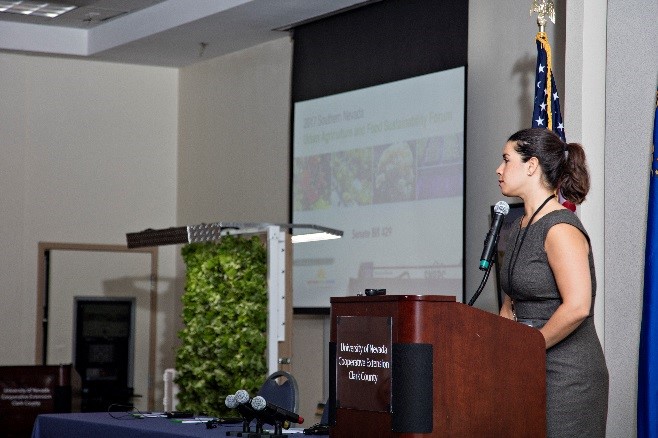 Sen. Yvanna Cancela listens to a question from the audience.
Sen. Yvanna Cancela listens to a question from the audience.
Opening Presentations
Opening presentations were designed to provide a foundation for concepts related to urban and indoor agriculture. SNS staff provided a review of the SNS Regional Plan, highlighting its food related strategies. Corrie Bosket, Extension coordinator of conservation issues, provided an overview of other food-related plans, policies, documents and related research including:
- The Governor’s Office of Economic Development brochure on Commercial Indoor Agriculture
- The Governor's Proclamations regarding STEM education and Food Day from Oct. 24, 2016
- The USDA Natural Resources Conservation Service’s resources on Urban Agriculture
- Southern Nevada Food Council White Paper
- City of Las Vegas Food Access Policy & Planning Guide
- City of Las Vegas R-44-2013 Resolution committing the city to increasing access to healthy foods and adopting a food access policy and planning guide
- Hydroponics and high tunnels research from the College of Agriculture, Business and Natural Resources at University of Nevada, Reno
- Public Law 114-59, STEM Education Act of 2015
- SB 429, Urban Ag bill
- SB 167, School Garden bill
- Nevada's Strategic Planning Framework, 2016-2020
- Food Security in Nevada: Nevada’s Plan for Action, Feb. 7, 2013
- City of Henderson Local Foods, Local Places Action Plan
A brief explanation of SB 429, an act establishing provisions relating to urban agriculture, was provided by Sen. Yvanna D. Cancela, chair of the Committee on Natural Resources, who introduced the bill during the 79th (2017) Session of the Nevada Legislature. The Senator explained the intent of the bill was to make it easier to grow locally, and she acknowledged that more work needed to be done now that the bill was passed. This session concluded with a Council update highlighting the prior day’s meeting.
Keynote Session: “Food Strategies in Southern Nevada: Steps to Success”
In Robert’s keynote presentation, he shared his expertise to help southern Nevada take the next steps toward developing a strong food city. Highlights from his presentation included collaboration strategies, food city examples, and recommendations for implementation of strategic plans.
Panel: “The Food Nexus”
The next presentation was the panel discussion titled, “The Food Nexus,” led by Extension Public Health Nutrition Specialist, Aurora Buffington. Panelists included Principal of Green View Global, Rick Van Diepen; Director of the Vegas Roots Community Garden, Roz Brooks; and Strategic Director of Dietitians for Professional Integrity, Andy Bellatti. The discussion was opened with a presentation by Buffington addressing the food system from production to consumption. The panel discussion provided perspective into the complex relationships between food, water, energy, environment, health, and nutrition.
“Off the Wall” Chef Demonstration
The panel discussion was followed by the “Off the Wall” Live Chef Demonstration and Luncheon. Chef of Buzz Catering and Master Gardener, Joann Reckling, harvested fresh lettuce directly from the aeroponic living wall on display provided by Indoor Farms of America. Also on display was the hydroponic GrowWall from OPCOM Farm. Chef Joann prepared a garden salad using the different types of herbs and lettuce harvested from the wall while explaining many of the characteristics unique to the salad ingredients.
Presentations: “A Close Look inside Indoor Agriculture”
Following the luncheon, three indoor agriculture companies each gave presentations highlighting various aspects of indoor agriculture through vertical hydroponic and aeroponic technologies. These presentations complemented aspects of the Commercial Indoor Agriculture Report from the Governor’s Office of Economic Development. Presenters included CEO of Green Sense Farms, Robert Colangelo; Vice President of Urban Seed, Rachel Wenman; and CEO of Indoor Farms of America, David Martin. Each presenter shared personal experiences and insight into how vertical farming can be used to bring fresh, locally grown produce to anywhere in the world. Key points addressed how indoor farming can produce more food with less environmental impact and touched on the business model and economic viability of indoor agriculture.
Panel: “STEM, CTE, & Workforce Development for Urban Agriculture”
The next presentation was the panel discussion titled, “STEM, CTE, and Workforce Development for Urban Agriculture,” and was led by Executive Director of State Renewable Energy: Green STEM Education, Amber Bosket. The panelists consisted of academia professionals including University of Nevada, Las Vegas Professor and Program Coordinator of Career and Technical Education, Howard R.D. Gordon; Extension Social Horticulture Specialist, Angela O’Callaghan; and Clark County School District School-Community Partnership Program Coordinator, Cheryl Wagner. The discussion opened with a presentation by Bosket explaining STEM (Science, Technology, Engineering, and Math) and showing examples of local Career and Technical Education programs addressing high-tech urban agriculture. The panel discussion provided insight about how STEM and Career and Technical Education can prepare the future agriculture workforce through continuing education and interchangeable career pathways.
Closing Discussion
In closing, Roberts gave a summary of his recommendations that he spoke about during the Food Action Planning Committee Meeting and his afternoon keynote speech. The event concluded with a networking social to allow speakers and attendees to interact and engage in further discussion of the next steps to creating a robust food system in southern Nevada. Roberts has since produced a blog that includes his insight and recounts his visit (Roberts, 2017).
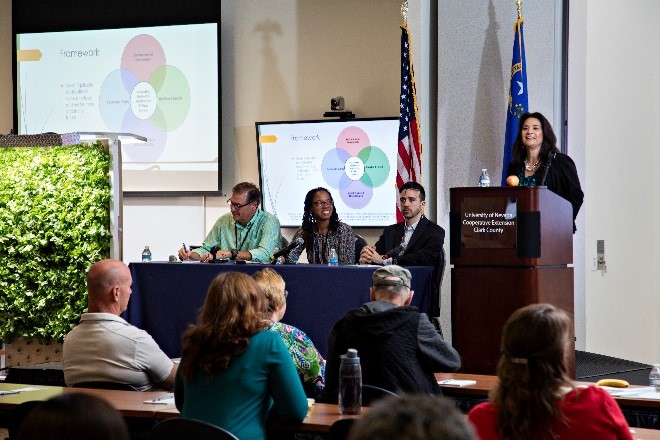 Aurora Buffington explains healthy, sustainable and resilient food systems.
Aurora Buffington explains healthy, sustainable and resilient food systems.
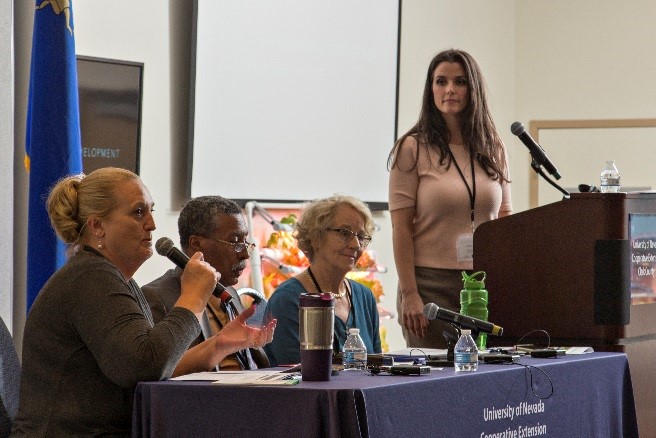 Panelist Cheryl Wagner responds to a STEM-related question.
Panelist Cheryl Wagner responds to a STEM-related question.
The day’s events were moderated by Extension Coordinator of Conservation Issues, Corrie Bosket, and the event included a catered breakfast and lunch, and afternoon snacks. The planning committee for the event included Corrie Bosket, Extension Coordinator of Conservation Issues; Aurora Buffington, Extension Public Health Nutrition Specialist; Millicent Braxton-Calhoun, Extension Healthy Food Systems Program Officer; Raymond Hess, Regional Transportation Commission Director of Planning Services; Rae Lathrop, Regional Transportation Commission Regional Planning Manager; Paul Gully, Regional Transportation Commission Management Analyst; Shane Ammerman, Clark County Planning Manager; Mario Bermudez, Clark County Planning Manager, Jared Tasko, Clark County Senior Planner; Wayne Roberts, Canadian Food Policy Analyst; Rick Passo, Food Hub Strategist; Rick Van Diepen, Principal of Green View Global; and Amber Bosket, Executive Director of State Renewable Energy: Green STEM Education. The forum recorded 118 attendees, not including additional unregistered attendees.
Extracurricular Activity
To complement the forum, a planning group tour of urban agriculture sites in the Las Vegas Valley was scheduled to give a hands-on perspective of what can be done in the region. The tour was originally scheduled for Aug. 22, 2017, but was canceled due to flight delays. Thus, a revised tour took place the Saturday following the forum on Aug. 26, 2017. This tour, attended by a group of food-system specialists, included stops at the Zion Community Garden Park, Indoor Farms of America, and University of Nevada Cooperative Extension. The tour developed into a food harvesting experience that led to a farm-to-plate dinner. At each stop, produce was gathered for the preparation of a meal that evening, which was attended by the group, as well as food producers from the various tour stops (Bosket, 2017).
Evaluation and Participant Feedback
By the numbers:
- Attendance on day one: 53
- Attendance on day two: 118
- Survey responses: 77
Food Action Planning Committee Meeting feedback was obtained using five possible responses which included: excellent, adequate, neutral, needed improvement or N/A. The percentage of total respondents giving an excellent or adequate rating follows:
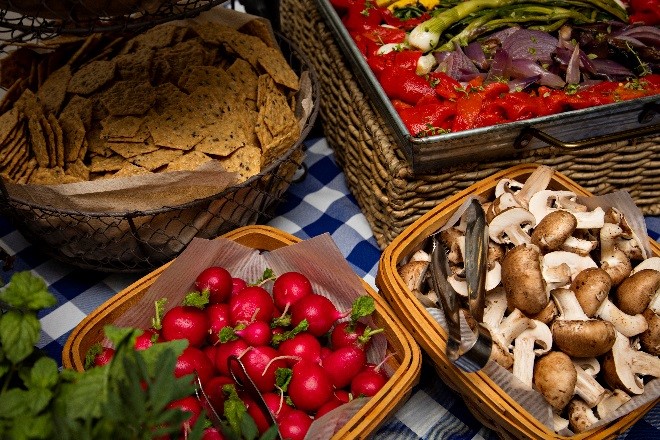 Fresh vegetables served at the forum.
Fresh vegetables served at the forum.
- Council Update: 48 of 52, 92 percent
- SNS Goals and Objectives: 52 of 55, 95 percent
- Planning Sessions/ Brainstorming Activity: 42 of 51, 82 percent
- Food Action Recommendations by Roberts: 52 of 54, 96 percent
- Food: 55 of 56, 98 percent
- Venue: 57 of 57, 100 percent
Thirty-five responses were provided when asked for one takeaway from the Food Action Planning Committee Meeting (Table 2). The most common words found in the responses include:
Urban Agriculture and Food Sustainability Forum feedback was obtained using five possible responses which included: excellent, adequate, neutral, needed improvement or N/A. The percentage of total respondents giving an excellent or adequate rating follows:
- Garden Tour: 18 of 19, 95 percent
- Food: 46 of 47, 98 percent
- Venue: 43 of 45, 96 percent
- "Off the Wall" Live Chef Demonstration: 43 of 47, 91 percent
- Networking Social: 33 of 36, 92 percent
Twenty-eight responses (after removing “did not attend” responses) were provided when asked for one takeaway from the Urban Agriculture and Food Sustainability Forum (Table 3). The most common words found in the responses include:

Respondent opinions on how well specific program elements contributed to meeting Urban Agriculture and Food Sustainability Forum goals was obtained using four possible responses which included: greatly contributed, fairly contributed, neutral or did not contribute. The percentage of total respondents giving ratings of fairly or greatly contributed to forum goals follows:
- Opening Presentations: 46 of 50, 92 percent
- Keynote Speaker: 47 of 49, 96 percent
- Food Nexus Panel: 43 of 46, 93 percent
- Presentations: 40 of 44, 91 percent
- STEM, CTE & Workforce Development Panel: 36 of 43, 84 percent
- Closing Discussion: 35 of 42, 83 percent
Nineteen responses were provided when asked what additional topics/conversations that would have helped meet the overall forum goal (Table 4). The most common words found in the responses include:

Fifty people responded to how they were interested in supporting the Southern Nevada Food Council. Following are the responses (and percentages) for each proposed role:
- Active board member: 17 (33 percent)
- Sub-committee volunteer: 24 (46 percent)
- Meeting attendance: 17 (33 percent)
- Unable to commit: 12 (23 percent)
Fifty-four people classified themselves as representing the food system in the following manner:
- Food production: food crops, animals, or seafood – 11 (20 percent)
- Food labor: culinary, hospitality, institutional – 1 (2 percent)
- Environment, climate & sustainability – 14 (26 percent)
- Food retailer, distribution or marketing – 3 (6 percent)
- Food safety & regulation – 3 (6 percent)
- Food processing or added value – 1 (2 percent)
- Education – 34 (63 percent)
- Policy, legislation or advocacy – 11 (20 percent)
- Waste, composting, recycling – 3 (6 percent)
- Eater, consumer – 21 (39 percent)
- Food insecurity, hunger, food pantry or food bank – 10 (19 percent)
- Health – 15 (28 percent)
- Other – 6 (11 percent)
Respondents were able to provide more than one response, and it is interesting to note that not everyone identified as an eater/consumer, although everyone eats. Among those that responded in the other category, responses included: government, higher education, rural community member and commercial food service specialist for a local utility company.
People attended for a variety of reasons and in the following order of importance:
- Learning: #1
- Networking: #2
- Curiosity: #3
- Contributing: #4
- Obtain professional education credits: #5
Learning, or adding to one’s knowledge base, was by far the most important reason for attending with 67 percent of the total 54 respondents rating this reason as their primary reason for attending. This forum was approved to provide up to 6 Certification Maintenance (CM) credits for certified planners.
Conclusion
A healthier, more resilient and sustainable food system is possible in Las Vegas by means of efforts such as the implementation of food-related activities contained in the SNS Plan objectives, as well as a community wide effort to increase local food production and food distribution through urban agriculture. Additional research support from the area’s institutions of higher education would greatly benefit the movement, as local data is limited. Urban agriculture, whether it be from a commercial-scale indoor agriculture operation or small urban farms, will not only help build a stronger local food system by increasing local production thus contributing to food independence, it will provide opportunities for economic diversification and job creation. Nevada’s hospitality industry spends over $2 billion every year on food brought in from outside the state (Nevada Governor’s Office of Economic Development, 2013). Much of that demand is from high-quality restaurants that are willing to feature locally grown products on their menus, so there is a need for quantity as well as quality food items. A limited amount of scholarly publications provide evidence that urban agriculture projects can lead to job creation, training, and small-business start-ups (Golden, 2013). Locally produced food will help keep more money in the local community while increasing resilience.
Southern Nevada is a logical place to launch urban agriculture projects with an emphasis on controlled environment agriculture, which provides a more sustainable method to grow food through the use of resource-saving technological advances. Las Vegas, located in the Mojave Desert, with its arid climate and abundant source of energy from the sun, recently became one of the nation’s largest cities to be 100 percent powered by renewable energy (City of Las Vegas, 2018), and Nevada was ranked among the top 10 states for sustainable building design by the U.S. Green Building Council. Environmental sustainability is important to southern Nevadans and controlled environment agriculture projects will help strengthen the local food system in a sustainable manner.
The potential benefits associated with urban agriculture, however, do not stop with economic or environmental impacts. Urban agriculture has the potential to positively impact community health and well-being. Urban agriculture, including aquaponics and gardening in the home, school, and community settings, may help reduce food insecurity by providing a means for residents living in food deserts to produce their own food and become more self-reliant. Urban agriculture may help revitalize blighted areas, reduce crime and build stronger social connections, while providing an avenue for added-value entrepreneurial opportunities through cottage food operations and other small-business enterprises. The increased availability of fresh produce may also help increase dietary intake of fruits and vegetables, which are beneficial in the prevention of chronic disease and help residents eat in a more health-promoting manner, thereby increasing quality of life (Golden, 2013). Urban agriculture is a promising strategy to help build a healthier, more sustainable and resilient food system.
The Food Action Planning Committee Meeting and the Urban Agriculture and Food Sustainability Forum brought together professionals from government, academia, health and food-related industries to address how urban agriculture can be used to increase food sustainability and food security, and build a stronger food system. The diverse line-up of speakers and topics gave attendees a well-rounded perspective and a strong foundation to help take the next steps to establishing food resiliency in southern Nevada.
Table 2 – What is one takeaway from the Food Action Planning Committee meeting that you would like to share?
| Takeaway |
| All levels of people are finally in one place meeting and trying to get to know each other to work together |
| It was a great, collaborative event. |
| We need STEM workers to fill the jobs that can exist with indoor Ag. Also eating salad picked fresh off an actual hydroponics wall. Great stuff. |
| I'm happy to be a small part in creating an action plan with other like-minded individuals from all sectors of the city. |
| Food is so powerful in each individual and group's lives because it impacts social, emotional and physical well-being. |
| I met people with a common goal: improving the lives of people in Southern Nevada. |
| Potential Collaboration. |
| Great to see local things happening and making this connection for people. |
| I thought the speakers were excellent! |
| Meeting Dr. Roberts and exchanging ideas about Bio-Char. |
| There is a large potential for indoor urban agriculture in Southern NV. |
| The critical importance of an action plan as well as an implementation plan. |
| That there is a lot of passion and there are a lot of resources available. We just need to increase the communication and link everything together in ways that make sense in order to make big changes. |
| What the industry is doing and what the future looks like. |
| We need to create a multidisciplinary, multi-agency food council with multiple stakeholders from across sectors, not just one organization. |
| I really enjoyed the dedication and passion that the speakers [had] regarding the topic. |
| This meeting got me excited for the future of food policy in Las Vegas. |
| Our community has the resources but needs a group like this to pull us all together. |
| I think it’s a great time to start an action plan for southern Nevada as urban farming is coming to Las Vegas. I’m looking forward to being a small part in this evolution. |
| The future is food economy and sustainability. |
| That we can attain food sustainability in Southern Nevada with planning. |
| A very interesting and well-planned event. I learned a lot. The food was also excellent. |
| All the great efforts in the Southern Nevada Valley working together! |
| I loved hearing about the upcoming farms/gardens coming to Las Vegas. |
| We had so much energy and talent in that room; if only we could help everyone make the Food Council a priority! |
| Each person makes 300 food decisions a day, we only need to influence a few to make a difference. Also, there are a lot of good people doing a lot of good things to promote sustainability in Las Vegas. |
| A lot of focus on smaller-scale tourist-oriented food sources that ultimately aren't going to mitigate the reliance on importing food from other states. |
| There are so many topics discussed that follow up one-day meetings focused on one topic only should be done. |
| Please keep the momentum going with future policy action. Thank you for a great event. |
| Optimism about creative solutions to critical food production and distribution issues for today and the future. |
| Companies are operating locally to further indoor agriculture. |
| I always enjoy the updates of what programs are being implemented in Las Vegas. |
| There is so much interest and momentum in Southern Nevada towards local food and increasing access to locally grown produce. It's exciting to see so many interested parties come together to discuss common goals. |
| I feel there are endless possibilities for urban agriculture to grow in Southern Nevada if all the different groups will get together. |
Table 3 – What is one takeaway from the Urban Agriculture and Food Sustainability Forum that you would like to share?
| Takeaway |
| A lot of knowledge on urban ag in our community. |
| Eating hydroponic food. |
| A community with great ideas I love to stay in touch with. |
| I would like to see more sectors of the city and county. I would also like to see more collaboration with UNLV. |
| There are a lot of different groups and individuals working on food sustainability in the valley. We just need to work together. |
| I found it very interesting to learn about the role that local food production could play in social interaction as presented by Wayne Roberts. |
| This has been a great starting point for this important topic. |
| Dr. Robert’s presentation, both in the morning and his closing remarks! |
| There are many support structures in the community that can work together on this. |
| There is a lot of opportunity for indoor urban agriculture in Southern Nevada. |
| The importance of a food plan action plan. |
| Knowledge about hydroponics. |
| Ideas about starting a community garden. |
| Our community has a wealth of resources that necessitate a coordinating body to better implement change in our community. |
| Urban Agriculture is gaining traction in all sectors of society. |
| Would have liked to have seen the portions directly related to schools and teaching earlier. |
| Dr. Wayne Roberts was an amazing keynote speaker. |
| Great presentation of information. |
| The lunch demonstration with the food wall. |
| Too many for-profit enterprises - not that it was bad to have them, just that it would have been better with a better cross-section of the interested parties in the valley. |
| Excellent. |
| We are still very dependent on other states/regions. Small ag can only benefit the community in supplemental ways. |
| The Indiana Garden that was awesome. |
| The amount of food that goes to waste and the number of people who go hungry here in Southern NV. I loved the whole meeting and I sense a brighter future for us after hearing the speakers and meeting with the champions! It was very inspiring and I cannot wait to see what changes are made from these amazing individuals fighting the good fight. |
| Excellent speakers and presenters, great food, and wonderful venue. |
| Optimism. |
| 9 days to rioting if we have no local food source and transportation of food stops. |
| Good information and participation. |
Table 4 – What additional topics/conversations do you feel would have helped meet the overall forum goal?
| Takeaway |
| Jobs for adults, not just kids. |
| Putting together a plan, education, next steps. |
| Was a great start, lots of information. |
| I was not able to attend the opening presentations or the closing discussion. I would have liked to see the event promoting recycling and composting as a model for the participants. |
| What the city/state is doing to help create indoor agriculture. |
| Having a panel of people who experience food insecurity. |
| Start of a plan for urban ag. |
| More momentum to creating a food hub. |
| Next steps - actionable items. |
| The technical aspect! How are things grown? |
| Funding available. |
| Handout, factsheet, or presentation of a list of places in Southern Nevada of urban (indoor and outdoor) farms. |
| Healthy Food Procurement. |
| A panel on "Meeting the challenges of urban agriculture in Southern Nevada"! |
| Research on urban agriculture. |
| Supply chain; growing regions. Agricultural land use and water use/reclamation in SoNV/SW US. |
| Dr. Wayne Roberts suggested we get Economic Development and Millennials involved. What is Bio-Char? |
| Overview of successful projects & programs and their locations mapped and photos for each. |
References
- Bosket, A. (2017). Food specialists forage the Las Vegas Valley for locally grown food, then prepare a meal [web log post].
- Burgan, M. & Winne, M. (2012). Doing Food Policy Councils Right: A Guide to Development and Action.
- City of Las Vegas. (2018). Renewable Energy & Energy Efficiency. Sustainability.
- Golden, S. (2013). Urban Agriculture Impacts: Social, Health, and Economic: A Literature Review. UC Sustainable Agriculture Research and Education Program Agricultural Sustainability Institute at UC Davis.
- Jensen, D., Macinga, D., Shumaker, D. Bellino, R., Arbogast, J., & Schaffner, D. (2017). Quantifying the Effects of Water Temperature, Soap Volume, Lather Time, and Antimicrobial Soap as Variables in the Removal of Escherichia coli ATCC 11229 from Hands. Journal of Food Protection, 80 (6): 1022.
- Environmental Protection Agency. (2017). Green Vehicle Guide, What If More People Bought Groceries Online Instead of Driving to a Store?
- Johns Hopkins Center for a Livable Future. (2017). What is the food system? FoodSpan.
- Nevada Governor’s Office of Economic Development. (2013). Commercial Indoor Agriculture.
- Roberts, W. (2017). What grows in Vegas stays in Vegas [web log post].
- Southern Nevada Regional Planning Coalition. (2016). September 27, 2016, Coalition Board meeting minutes.
- Southern Nevada Strong. (SNS). (2015). SNS Regional Plan.
- This publication is also available as a PDF suitable for printing upon request. Contact Aurora Buffington for more information, 702-257-5534.
Buffington, A., and Bosket, C.
2017,
Evaluation of Food Action Planning Committee Meeting and Urban Agriculture and Food Sustainability Forum, August 23-24, 2017,
Extension | University of Nevada, Reno, SP-18-01


